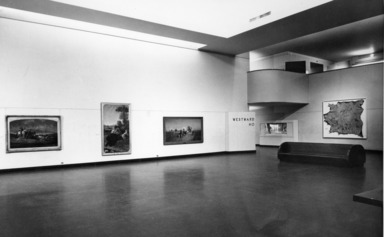
Westward Ho!
DATES February 09, 1949 through April 12, 1949
-
February 9, 1949
A special exhibition entitled “Westward Ho” opened at the Brooklyn Museum last night (February 8) with a preview for Museum members and guests. The exhibition will remain on view for the public from February 9 through April 10. Here is told the romantic story of the expansion of the United Status from the end of the 18th century to about 1860, by means of art objects which illustrate the white man’s penetration into lands new to him but ancient to the Indian.
The story begins with early government explorations which resulted from Jefferson’s decision to establish territorial rights in the western regions. The most famous of these expeditions was that made by Lewis and Clark who left St. Louis in 1804.
Shortly after this many traders and others who were just seeking adventure set out for the West. The reciprocal influences of both the white man and the Indian are shown clearly in costumes, weapons, saddles and various types of trade goods. It is interesting to see how the Indians who originally used porcupine quills to decorate their dress, began to replace them with beads obtained through trade and even considered coins and thimbles attractive ornaments. At the same time we find clothing made by the Indians in European style for the traders and their families.
The work of artists who were drawn to the West for love of adventure and sport or for science or for art produced exciting American paintings and prints. The following are represented in the show: John J. Audubon, Joseph Becker, George Caleb Bingham, Charles Bodmer, George Catlin, Samuel Colman, Seth Eastman, Alfred Jacob Miller, William T. Ranney, John Mix Stanley, A.F. Tait, Newbold Trotter, and Charles Wimar. Catlin was perhaps the most important of them as his numerous paintings, lectures and books spread the knowledge of the upper Missouri far and wide. Artists who were eager to make sketches and paintings of Indians and Indian life often joined an expedition going West. John Mix Stanley, for example, joined Sumner Dickman of Troy on a trip to Arkansas and New Mexico, later accompanied Governor Butler of Arkansas to a council of Indian chiefs, and also participated in the expedition of General Kearney who led the dangerous march overland to San Diego, California. Another artist, Seth Eastman, a soldier by profession, spent 20 years of military service making innumerable sketches and paintings of Indians with whom he came in contact. Some of the most interesting records of this period are the Currier and Ives prints, notably the famous “Westward the Course of Empire” series. Audubon, of course, left his carefully documented work on birds and animals.
One section of the exhibition is devoted to early household equipment and clothing in a simulated interior scene containing crude furnishings locally constructed as well as a few professionally made pieces. The dangers and difficulties of travel did not prevent these early settlers from transporting large pieces of furniture such as a mahogany chest of drawers which is shown. To complete the picture there are examples of lighting fixtures, spinning wheels, bed furnishings, skins and furs, cooking and hunting equipment, etc. The Navajo blanket exhibited shows an Indian impression of the building of the railroads which finally opened up the entire West.
The Brooklyn Museum is grateful to the following lenders to the exhibition: American Museum of Natural History, Harry MacNeill Bland, Denver Art Museum, Frederic H. Douglas, Mr. Joseph Downs, Kennedy and Co., Metropolitan Museum of Art, The University of Michigan, The Missouri Historical Society, New York State Museum, Albany, The Old Print Shop, Wolfgang Paalen, Union League Club, Union Pacific Railroad, United States National Museum, Washington University, Yale University.
Press preview: Monday, February 7th
10:00 A.M. to 5:00 P.M.
Brooklyn Museum Archives. Records of the Department of Public Information. Press releases, 1947 - 1952. 01-03/1949, 016-7.
View Original